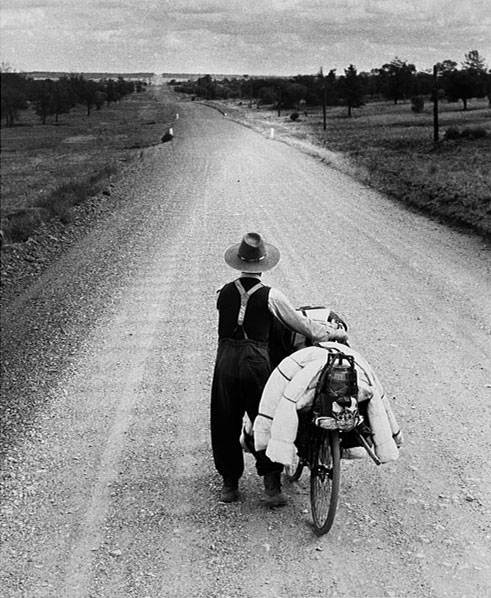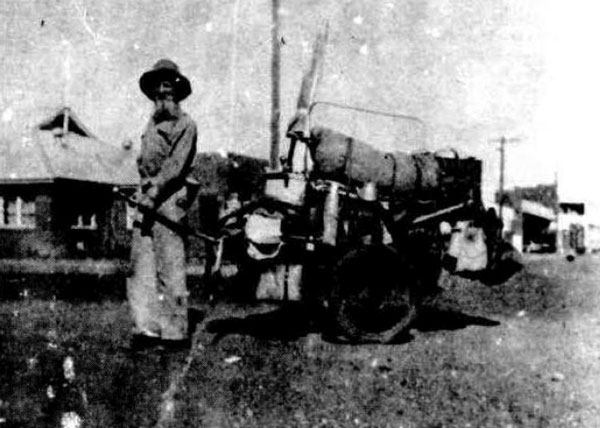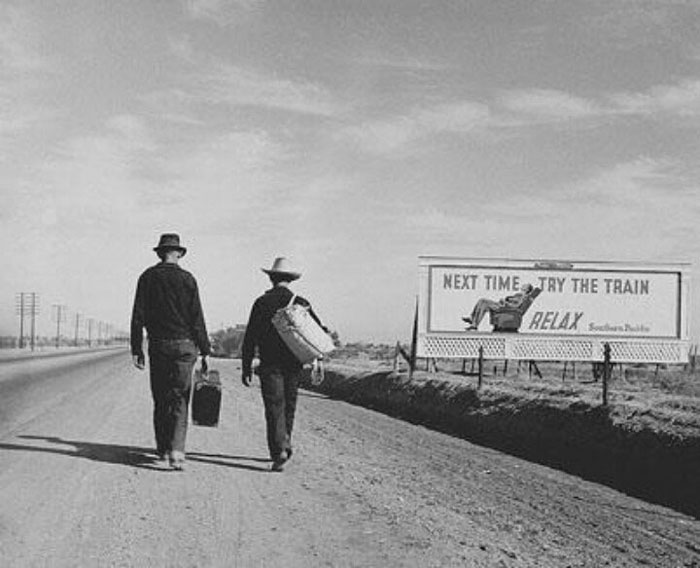|
1906 – 1986
The Swagman, 1954
 |
| Axel Poignant, Swagman on the road to Willcanna 1954 |
Gael Newton AM, October 2025
The photograph of The Swagman was taken by the Australian photographer, Axel Poignant – who had come to Australia from England as a young man in 1926 in search of adventure. Poignant experienced being unemployed and homeless before turning to photography to earn a living in the 1930s becoming a pioneer of the new documentary photojournalism in the booming illustrated magazines of the day.
Axel Poignant made his first photo essays on logging, mining and natural environments in and around 1930s Perth. He travelled along the Canning Stock route in 1942 meeting Aboriginal families and workers that inspired a post war self elected project in 1952 to record the Aboriginal communities along the Liverpool River in Arnhem Land. That extensive record had left an enduring legacy for future. (see link below for more on Axel Poignant)
One of Axel Poignant’s best known images, The Swagman, was made in 19541 probably while working in the arid country of western New South Wales.2 He was travelling with wife Roslyn on the Barrier Highway between Cobar and Wilcannia when they stopped to talk with a swagman pushing his heavily laden bicycle. The bike had no chains; it was a cart for carrying his swag.
The man told them his name was George Meredith and that he was working his way from Paroo to Wilcannia and then Menindee in Western NSW, a distance of 750 kilometres. He expected it would take him several months. They noted the bedrolls, billy cans and waterbag hanging from the frame and that there was a box of books strapped to the handlebars.
Although it is not known when the image was first published or exhibited, it became very popular from the time it was included in Poignant’s 1982 retrospective at the Art Gallery of New South Wales. It was also used on the cover of the catalogue. The captions identifying George Meredith were supplied by the Poignants for the exhibition.
Roslyn Poignant wrote of how Axel had climbed onto the platform on roof of their Fiat van with his Rollieflex to take several images of Meredith facing the very long flat road ahead.3 Two surviving contact sheets include close up and frontal images of Meredith. However Poignant marked up only a few for printing including the now iconic image from the car roof.
No other images of Meredith are known to have been printed or published by Poignant. His emphasis was on the mage of the swagman walking alone into the wide landscapes of Australia.
Meredith was no shabby dishevelled outback Australian swagman of the type depicted in words and images from the late 19th century until the 1960s. These itinerant workers travelled from place to place in search of seasonal work. Even if no paid work was available many people provided modest rations and a place to camp overnight. There is a lot of literature on the ‘sundowners’ as they were known. Swagman were still a common sight in the 1950s but their numbers were in decline.4
George Meredith is a small thin older man, neat and well dressed with a broad brim hat in good nick. He wears a warm vest and long sleeved shirt. His rolls, bedding and pillows are clean and bright; a metal cat face at the rear of the bike may have had reflector eyes to alert drivers to his presence. His boots are solid and pants clipped around them.
The unpublished close up images of Meredith in Poignant’s contact sheets show he is clean shaven with a neat white moustache. He is possibly in his 60s. It is quite likely he had been at a property recently and knew where the next stop would be for his personal presentation to be so well maintained. His provisions would last only a few days without replenishment.
Searching TROVE (National Library of Australia) under Meredith’s name showed up two articles in the Dubbo Western Magazine on 9 April and 7 May 1973. They identify George Meredith as a well known character, ‘Jack the Cook’ who did a regular circuit taking several years between Cobar, Bourke, Brewarrina,Walgett, Coonamble, Warren and Condobolin.
Meredith was an expert bush camp cook who had worked at Cobar District Hospital during the war years. He was known for keeping himself and his gear clean and tidy. The newspaper article quoted a local: He could turn out any tasty dish with his own simple gear under a tree or in the kitchen but prone to drinking bouts.
The 1973 newspaper article shows an older bearded Meredith with a new cart made for him by a grazier to carry all his equipment. A local in the May article reported Meredith had been found dead at his camp outside Byrock near Cobar and buried in Bourke cemetery.
When he took the images of George Meredith, Axel Poignant had been be a photojournalist since the mid 1930s and would have been aware of the classic documentary images of the American west during the depression which often featured lone itinerants on the endless desert roads. In Western Australia in the 1930s and early 1940s he had portrayed hard working drovers, miners, prospectors and the people he met along the Canning stock route in 1942.
 |
| Unknown photographer: George Meredith with his new cart, circa 1965 |
| |
 |
| Dorothea Lange, On the Road to Los Angeles, California. March 1937 |
In 1954 George Meredith knew where he was and where he was going. Axel Poignant was also well advanced in his career with considerable achievements and success behind him. Poignant had taken that sort of adventure himself as a young man coming to Australia in the 1920s to work on remote farms, falling ill and being homeless and living in a tent in Frenchs Forest outside Sydney. In 1954 he did not know that within a few years he would return to England with Roslyn and end up deciding to be based there – visiting Australia only a few times with one trip being for his 1982 retrospective.
Alex Poignant's published image of the swagman could be any quest into the unknown and many journeys and paths people choose to travel. It remains an Australian icon.
- The Swagman has been dated 1953/54; but in a 2010 article by Roslyn Poignant it was dated 1954.
- 'Leading Photographer Films Mines and Flying Doctor Service', Barrier Daily Truth (Broken Hill), Friday 30 April 1954, p 4.
- Roslyn Poignant. 'The Swagman's After Image'. Photofile 35, 2 (1992): 6-11
and 'The photographic witness', Photogenic Papers John Richardson (ed)
- For a personal account by a swagman see “Duke” Tritton, ‘Once a Jolly Swagman’,
Walkabout vol 26 n.12, 1 Dec 1960, pp22-27
For more on Axel Poignant
for more essays by Gael Newton
|


